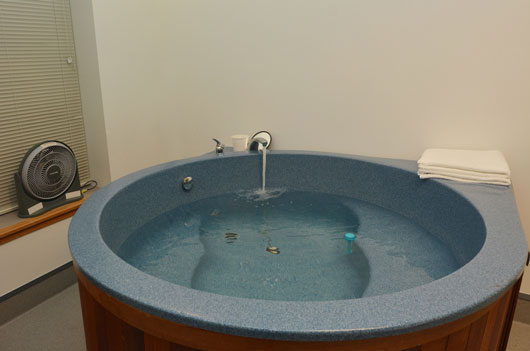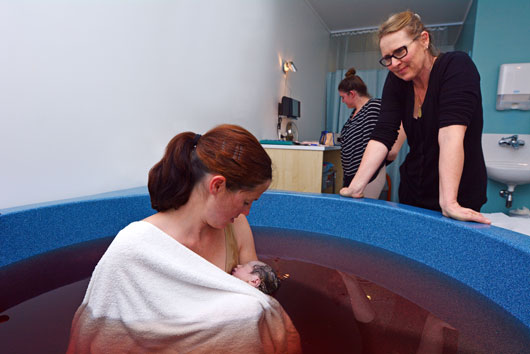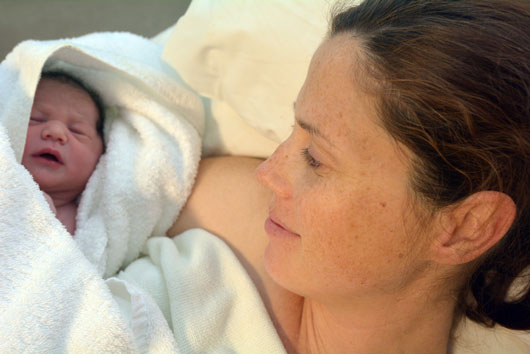
Having a baby is a crazy, magical and potentially terrifying experience for a lot of women, regardless of your birth plan. There are a lot of unknowns when you have a baby—when will I go into labor, how much will it hurt, will my baby be OK, will I be OK, what is the best way to deliver my baby, will I poop on the table? (Yes, the last one is a serious concern, yes it happens, and yes it will probably happen to you.) As to where and how you give birth, traditional labor and delivery in a hospital setting still makes up about 98% of childbirths in the United States, according to a recent report by CNN. That said, there has been a major rise in the number of alternative birth methods, including birthing centers, home births and water births in recent years.
If you’re sitting there trying to figure out exactly what a water birth is, allow us to enlighten you. It’s exactly what it sounds like. According to AmericanPregnancy.org, “water birth is the process of giving birth in a tub of warm water. Some women choose to labor in the water and get out for delivery. Other women decide to stay in the water for the delivery as well. The theory behind water birth is that since the baby has already been in the amniotic fluid sac for nine months, birthing in a similar environment is gentler for the baby and less stressful for the mother.”
Read Related: Deliverance: 20 Things to Consider when Making Your Birth Plan

Before you judge in one direction or the other, you should know all the facts about water births. First of all, you don’t pop a baby out in a hot tub or your neighbor’s pool. A water birth is a carefully monitored process when a woman gives birth in a birthing pool of water that is kept at 97 degrees Fahrenheit (aka, close to your body temperature.) The tub is often inflatable—picture a kid’s swimming pool, but cleaner and less colorful. A water birth can take place at a birthing center, a hospital or even your home.
There are several reasons why a woman would choose a water birth. For starters, Ami Burns, a Chicago-based childbirth educator and writer and owner of Birth Talk, explains that a water birth is “a gentle, natural experience.” She continues that women “find being submerged in a tub provides more comfort during contractions than being ‘on land.” For women who opt for a more natural childbirth experience, a water birth is an appealing choice that is becoming more common and accessible.

There are also several benefits to both the mother and baby with water births. For mothers, giving birth in water can help alleviate labor pain, can help you relax, help you find a more comfortable delivery position, can lower your blood pressure, reduce stress and cause the perineum to relax and expand naturally, allowing easier passage for your baby. For the baby, a water birth creates an environment that mimics the conditions inside the womb, so that when they enter the world they are less traumatized by their new surroundings. In addition, a less stressful birth typically results in fewer complications for the fetus during and after delivery.
Of course, there are certainly several risks involved with water births. And as with so many aspects of pregnancy, childbirth, and motherhood, there are a lot of misconceptions as well. As far as risks go, there is the risk of infection should the baby inhale contaminated water. If you have ever given birth before you know that your body releases a lot of different types of bodily fluids during labor (no comment), which leaves a lot of room for water to be contaminated. Recently, the American Academy of Pediatrics (AAP) and the American College of Obstetricians and Gynecologists (ACOG) released joint guidelines regarding water baths. They suggest that they can be beneficial to mothers and babies during the early stages of labor, but that there are potential severe risks to actually delivering in water.

Beyond that, there is no real proof to quantify the health benefits of a water birth. According to Dr. Jeff Ecker, an obstetrician at Massachusetts General Hospital and chair of the ACOG’s Committee on Obstetric Practice, which wrote an opinion for the report, “it is difficult to quantify those risks. The information that is out there [is incomplete and inconclusive].” He continues to say that “there is a potential for more risk with an underwater birth.”
At the end of the day, your birth plan is a very personal decision; every mother, ever baby and every situation is different. Do your research, ask all the necessary questions, do what makes you comfortable, do what is best for your family, and regardless, make sure you work with an experienced and trusted health care provider to ensure that you and your baby are safe and healthy during this special, life-changing experience.











